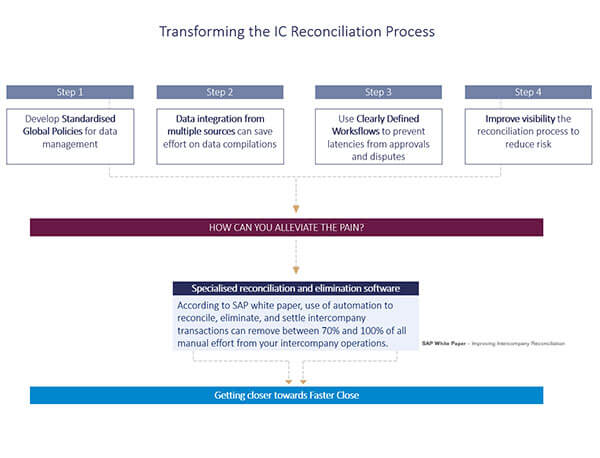4 Steps to transform your Intercompany Reconciliation

In a recent survey conducted by BPM International, 72% of the companies which participated noted that they are spending significant time clearing intercompany (IC) differences, while 31% of survey participants identified the process as a significant barrier to their financial close. Our work with clients showed that companies nowadays tend to move beyond the initial need to comply with legislation and are focusing instead on driving sustainability and control into their corporate processes. By improving on IC reconciliation, you can easily bring order to the data jungle and achieve a faster financial close.
In this blog post, read what makes IC reconciliation so difficult and how you can transform the IC reconciliation process easily.
Table of contents
What are the intercompany reconciliation challenges?
There are numerous reasons why intercompany reconciliation is so difficult. Here are the main challenges:
- Multiple controlling software: subsidiaries are on different ERPs, some of which may not be well-suited to capture the necessary details of intercompany transactions.
- Separate accounting structures exist.
- There could be timing differences, if subsidiaries have different year-ends.
- The reconciliation is done centrally, where the ‘corporate’ team compiles the consolidated results. Therefore, solving out-of-balance conditions entitles a repetitive ;process of going back and forth between ‘corporate’ and subsidiary accountants to chase clarifications, resulting in an inefficient communication process.
Transforming intercompany reconciliation in 4 steps
Our experience shows that transforming intercompany reconciliation is key to achieving more efficient and fast financial reporting and analysis. Therefore, the Figure 1 below outlines 4 key steps required to successfully transform your IC reconciliation processes.

Step 1: Develop standardized global policies
Companies spend an enormous amount of time agreeing on a wide variety of reporting practices being used. If the parent company categorizes and tags its transactions in one way and the subsidiaries do it differently, the result will be another data mess that your accounting teams have to deal with. Errors in your financial statements are almost inevitable.
Formalizing clearly defined governance and policies to subsequently automate the agreed rules eliminates the need for counter parties having to book and correct intercompany transactions. Having a single process for collecting and distributing intercompany transactional data eliminates any issues over currency values, transaction amounts, and tax implications.
The latest technologies take this a step further by using matching rules to perform intercompany matching based on tolerance levels and identify exceptions automatically. It enables accounting teams to focus on discrepancies without having to certify each account manually, and instead see summaries of differences between entities and drill into the details.
Step 2: Data integration from multiple sources
The research study ‘The Future of Financial Reporting (FSN, 2018)’ highlights significant frustration among finance teams about the problems of extracting data from the source systems. A quarter of respondents to its survey complained that they spend too much time collecting data from multiple sources.
Using finance software that is compatible with all sources of data removes the need to convert your data into a specific format before it is imported. Live integration combined with comprehensive matching capabilities gives you real peace of mind that your intercompany reconciliations are thorough, accurate and on time.
Step 3: Clearly defined workflow
Going back and forth on email with disputes around the reasons behind intercompany discrepancies can often become a high burden on the finance teams. On the other hand, structured workflow ensures that all steps of the intercompany reconciliation process are completed in a logical order, subject to the required approvals and controls.
Workflow and controls enable organizations to manage disputes using approval processes, monitoring, and management of resolution all the way through to correction, including routing to the correct staff to decide which legal entity is liable.
Step 4: Improved visibility
Despite a growing complexity of business, traditional approaches to intercompany accounting do little to remove risk from the process and provide limited if any visibility upon the status of intercompany reconciliations.
Technology-enabled solutions offer the capability to monitor real time the progress of intercompany reconciliations at any point during the month. Customizable analytics and dashboard capabilities provide visibility to authorized users to track status and progress by selected criteria, for example company, region or close milestones.
Summary: How to transform IC reconciliation
It’s clear that companies could save time if their reporting units adopted a peer-to-peer reconciliation process to communicate and resolve differences directly with one another, thereby moving the responsibility for getting things right from central finance team to the reporting units themselves.
Although this seems the obvious way forward, research shows that organizations find such transformation quite challenging and complex, resulting in only 4% of companies achieving the leading maturity level of the IC reconciliation process (Deloitte Development LLC 2017).
Nonetheless, developing companies should note that by applying technology for intercompany reconciliation, you can make radical process changes with little effort and potentially achieve significant gains in efficiency. These gains aren’t all financial in nature and can include easing the burden on the central finance function and transforming its role into that of supervisor rather than executor of the IC reconciliation process.
We have summarized how a professional FPM software can help you to optimize intercompany reconciliation. Take a look at our solution page:
